- Home
- About
- Map
- Trips
- Bringing Boat West
- Migration West
- Solo Motorcycle Ride
- Final Family XC Trip
- Colorado Rockies
- Graduates' XC Trip
- Yosemite & Nevada
- Colorado & Utah
- Best of Utah
- Southern Loop
- Pacific Northwest
- Northern Loop
- Los Angeles to NYC
- East Coast Trips
- Martha's Vineyard
- 1 Week in Quebec
- Southeast Coast
- NH Backpacking
- Martha's Vineyard
- Canadian Maritimes
- Ocracoke Island
- Edisto Island
- First Landing '02
- Hunting Island '02
- Stowe in Winter
- Hunting Island '01
- Lake Placid
- Chesapeake
- Provincetown
- Hunting Island '00
- Acadia in Winter
- Boston Suburbs
- Niagara Falls
- First Landing '99
- Cape Hatteras
- West Coast Trips
- Burning Man
- Utah Off-Roading
- Maui
- Mojave 4WD Course
- Colorado River Rafting
- Bishop & Death Valley
- Kauai
- Yosemite Fall
- Utah Off-Road
- Lost Coast
- Yosemite Valley
- Arizona and New Mexico
- Pescadero & Capitola
- Bishop & Death Valley
- San Diego, Anza Borrego, Joshua Tree
- Carmel
- Death Valley in Fall
- Yosemite in the Fall
- Pacific Northwest
- Utah Off-Roading
- Southern CA Deserts
- Yosemite & Covid
- Lake Powell Covid
- Eastern Sierra & Covid
- Bishop & Death Valley
- Central & SE Oregon
- Mojave Road
- Eastern Sierra
- Trinity Alps
- Tuolumne Meadows
- Lake Powell Boating
- Eastern Sierra
- Yosemite Winter
- Hawaii
- 4WD Eastern Sierra
- 4WD Death Valley +
- Southern CA Deserts
- Christmas in Tahoe
- Yosemite & Pinnacles
- Totality
- Yosemite & Sierra
- Yosemite Christmas
- Yosemite, San Diego
- Yosemite & North CA
- Seattle to Sierra
- Southwest Deserts
- Yosemite & Sierra
- Pacific Northwest
- Yosemite & South CA
- Pacific Northwest
- Northern California
- Southern Alaska
- Vancouver Island
- International Trips
- Index
- Tips
- Books
- Photos/Videos
- Search
- Contact
Chiang Rai, Thailand
Tuesday, March 20, 2018 - 9:45am by Lolo
250 miles and 6 hours from our last stop - 2 night stay
Travelogue
Day 1 - Wat Rong Khun (The White Temple)
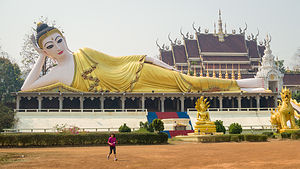 Roadside Reclining BuddhaToday would be an even longer driving day than yesterday, over 6 hours, and with more mountainous twists and turns.
Roadside Reclining BuddhaToday would be an even longer driving day than yesterday, over 6 hours, and with more mountainous twists and turns.
Udom was constantly making sure that we were happy and comfortable along the way. Part of that task involved finding suitable restrooms, which apparently got more and more challenging as we ventured into the rural northern part of the country. Rather than Western style toilets with toilet paper, most of Thailand uses a toilet hose, or as it is affectionately referred to, a “bum gun.” I won’t get into the sordid details, as I’m sure “bum gun” creates a vivid enough visual image. I followed Udom’s sage advice and tucked some tissues in my pocket.
About two hours north of Sukhothai, we made our first Buddha stop of the day. I am convinced that you could devote a lifetime to visiting each Buddha in Thailand and never finish the task. After all, there are over 33,000 Buddhist temples in Thailand.The only thing equally ubiquitous are portraits of the king.
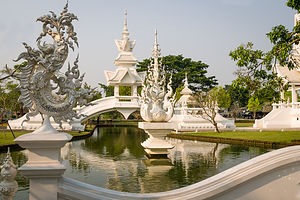 White Temple of Chiang RaiThis particular Buddha was a huge reclining Buddha, in the same pose as the famous golden one we had seen in Bangkok’s Wat Pho.
White Temple of Chiang RaiThis particular Buddha was a huge reclining Buddha, in the same pose as the famous golden one we had seen in Bangkok’s Wat Pho.
Udom explained that each Buddha pose and accompanying hand gestures has a significance related to an important event in his life. A reclining Buddha depicts the last moments of his final life on earth, before entering Nirvana. In this pose, the Buddha is always depicted lying on the right hand side on top of a resting table. As with many depictions of the Buddha, this one’s features were quite delicate and feminine.
Back on the bus, Udom announced that we would be stopping for lunch in a few hours at a restaurant on the shores of Kwan Phayao, Thailand’s largest freshwater lake. As I’ve mentioned before, Udom just oozes with love and pride for his country, so he was quite excited to show off a bit of Thailand’s natural beauty at this popular resort.
 Lolo crossing the bridge of the "cycle of rebirth";After being in cities for the previous week, we too were anxious for some non man-made attractions. Unfortunately, March is the time of the year when farmers burn their rice fields to prepare for the next planting, so the air was so thick with smoke and haze that the lake and surrounding mountains were hardly visible. Plus, it wasn’t all that great for breathing either.
Lolo crossing the bridge of the "cycle of rebirth";After being in cities for the previous week, we too were anxious for some non man-made attractions. Unfortunately, March is the time of the year when farmers burn their rice fields to prepare for the next planting, so the air was so thick with smoke and haze that the lake and surrounding mountains were hardly visible. Plus, it wasn’t all that great for breathing either.
Lunch was good though, and afterwards we took a brief stroll along the waterfront. Unlike the lakes we are used to in the states, there was little to no activity out on the water - just a few men fishing along its shores.
Only one more hour on the bus, and we were finally at our main destination for the day - Wat Rong Khun, better known as the “White Temple,” which out of the dozen or so Wats we would visit on our tour, was in my opinion, the most spectacular.
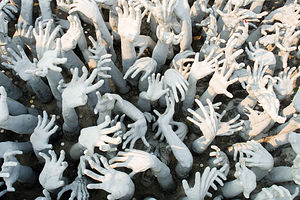 The beseeching hands of the suffering at the White TempleIt was unlike any temple we had seen so far. Everything was a brilliant white, and the pieces of glass embedded in the plaster made the buildings shimmer and sparkle even more in the sunlight. Besides creating a stunningly beautiful effect, the choice of colors and materials had a symbolic meaning as well. White signifies the purity of the Buddha, and glass symbolizes wisdom and self-reflection.
The beseeching hands of the suffering at the White TempleIt was unlike any temple we had seen so far. Everything was a brilliant white, and the pieces of glass embedded in the plaster made the buildings shimmer and sparkle even more in the sunlight. Besides creating a stunningly beautiful effect, the choice of colors and materials had a symbolic meaning as well. White signifies the purity of the Buddha, and glass symbolizes wisdom and self-reflection.
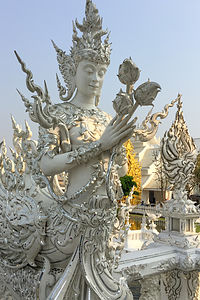 "Kinaree"; on the bridge of the "cycle of rebirth";As far as Buddhist wats go, this temple is a baby compared to those we had previously visited in Bangkok, Ayutthaya, and Sukhothai, and quite contemporary and unconventional in style.
"Kinaree"; on the bridge of the "cycle of rebirth";As far as Buddhist wats go, this temple is a baby compared to those we had previously visited in Bangkok, Ayutthaya, and Sukhothai, and quite contemporary and unconventional in style.
The original Wat Rong Khun that was on these grounds was in a bad state by the 1990s, and despite efforts to restore it, the project was canceled due to lack of funds. That’s when a famous Thai visual artist from Chiang Rai, named Chalermchai Kositpipat, stepped in and offered to completely rebuild the temple with his own money. He wanted it to be a center of learning and meditation for the people of Chiang Rai - a very generous gesture on his part.
Today, Wat Rhon Khun is very much a work in progress and is not expected to be completed until the end of the century. Eventually there will be nine buildings, including a meditation hall, an ubosot (ordination hall), a hall to enshrine Buddhist relics, living quarters for monks, and an art gallery.
A major setback occurred in 2014, when a 6.3-magnitude earthquake hit Chiang Rai, badly damaging the White Temple. At first, Kositpipat declared that the damage was so great that the temple would have to be demolished. However, on further inspection, it was determined that the cracked pillars, damaged murals, and broken spires could be repaired, so he forged on. The process took about two years and the damaged buildings have reopened.
Besides being beautiful to look at, every detail of the temple carries meaning and is meant to encourage visitors to reflect on the Buddhist teachings and show the way to escape from worldly temptations, desires, and greed and to focus on the mind instead.
 Creepy heads hanging from trees at the White TempleWe started our tour of the temple (and our journey to Nirvana) by crossing the bridge of the “cycle of rebirth,” towards the ubosot, the main building of the temple complex. It was a little unnerving to pass over a pool of upturned, beseeching hands representing the suffering souls destined to hell by their greed and desire. As we proceeded across the bridge, we were symbolically leaving worldly temptations behind and heading towards a state free of desire and suffering.
Creepy heads hanging from trees at the White TempleWe started our tour of the temple (and our journey to Nirvana) by crossing the bridge of the “cycle of rebirth,” towards the ubosot, the main building of the temple complex. It was a little unnerving to pass over a pool of upturned, beseeching hands representing the suffering souls destined to hell by their greed and desire. As we proceeded across the bridge, we were symbolically leaving worldly temptations behind and heading towards a state free of desire and suffering.
While crossing the bridge, we ran into two old “kinnaree” (half woman, half bird) friends, like the ones we had seen at the Grand Palace in Bangkok, except these were brilliant white rather than gold and much more ornate and flamboyant. Their role is to watch over the well-being of humans in times of trouble or danger, which I guess we were in until we made it to the other side of the bridge.
We still had a few more demons to pass by before reaching the safety of the ubisot. After crossing the bridge we arrived at the “Gate of Heaven,” guarded by two huge, scary creatures, that represented Death and Rahu, who decides man’s fate. They were wielding some very threatening weapons.
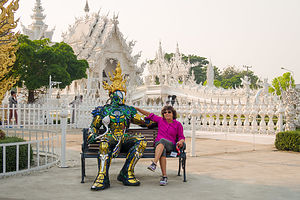 Lolo making friends at the White TempleFinally we stood before the ubisot, which like the other structures in the temple complex was a brilliant white with fragments of reflective glass set into the plaster, sparkling in the afternoon light. Although much more ornate than most Thai temples, it did have the traditional three-tiered roof with lots of serpents and blade-like projections sticking out of it - except this one was a lot more glitzy and gaudy.
Lolo making friends at the White TempleFinally we stood before the ubisot, which like the other structures in the temple complex was a brilliant white with fragments of reflective glass set into the plaster, sparkling in the afternoon light. Although much more ornate than most Thai temples, it did have the traditional three-tiered roof with lots of serpents and blade-like projections sticking out of it - except this one was a lot more glitzy and gaudy.
Upon entering the temple, we immediately saw why it was so controversial. Rather than covering the walls with scenes from the life of the Buddha, as most temples in Thailand do, Kositpipat chose to use contemporary characters and events from the popular culture of the West to depict good and evil.
The murals of the White Temple are covered with modern cultural icons, such as Batman, Elvis, Superman, Neo from the Matrix, Harry Potter, Angry Bird, and even Hello Kitty. The message was somewhat confusing to me - is Angry Bird evil or just having a bad day? What about Hello Kitty? There are images of 9/11, nuclear warfare, terrorist attacks, and oil pumps all driving home the fact that human beings are evil and destructive.
My biggest regret is that we were not allowed to take photographs inside the temple, because you could literally study the murals for hours and still discover something new.
 Fancy urinals at the White TempleOn the back wall there is a golden mural of the Buddha and a few images of the Buddha in front of it. It is this juxtaposition of traditional Buddhist imagery and pop culture that has drawn criticism from the Thai government.
Fancy urinals at the White TempleOn the back wall there is a golden mural of the Buddha and a few images of the Buddha in front of it. It is this juxtaposition of traditional Buddhist imagery and pop culture that has drawn criticism from the Thai government.
On the temple grounds there was more to perplex our minds - severed heads hanging from trees, a larger-than-life silver and gold robotic type figure that I sat down next to on a bench, and more.
Amongst all the white buildings, there was one golden one that stood out. To our surprise, this ornately decorated building was a restroom. The symbolism of the color is that gold represents the body and is for lay people, while white represents the mind and the enlightened. My unenlightened Herb took a photo in the men’s room of the elaborate golden carvings above four urinals. It was beautiful.
The White Temple had been a truly amazing stop, so exquisite and thought provoking!!
 Pool at Le Meridien Chiang RaiRight on time, the Gate1 bus picked us up at the exit and took us to our hotel, Le Meridien Chiang Rai Resort, where we would be spending two nights. It probably is the nicest hotel I have ever stayed in. It was nice to be in a rural setting for a change, where we didn’t have to experience the sounds and smells of a city - just crickets and the smells of food from the outside BBQ.
Pool at Le Meridien Chiang RaiRight on time, the Gate1 bus picked us up at the exit and took us to our hotel, Le Meridien Chiang Rai Resort, where we would be spending two nights. It probably is the nicest hotel I have ever stayed in. It was nice to be in a rural setting for a change, where we didn’t have to experience the sounds and smells of a city - just crickets and the smells of food from the outside BBQ.
The pool was absolutely lovely. It was Happy Hour so I ordered a glass of Chardonnay from the poolside bar - finally, a glass of wine. For awhile there I thought Thailand only had Chang and Singha beer. We live in Sonoma Valley now, so I was starting to have withdrawal.
At dinner, I ordered a second glass, forgetting it was no longer Happy Hour. When I did the math afterwards, I realized that my 500 baht glass of wine was $18 - oops! It was surprising, because everything up to that point had been so inexpensive. In Bangkok $18 got both Herb and I dinner and a Chang beer. Still, the wine was worth it.
Day 2 - Myanmar, lunch at a farm in Thailand, longtail boat to Laos
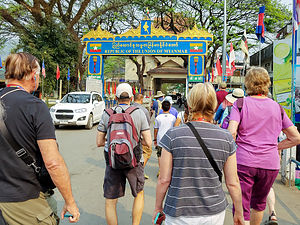 Border crossing into MyanmarOur Gate1 itinerary had been pretty aggressive already, but today we were going to take it up a notch and throw in a quick dip into Myanmar and Laos. I should have read the itinerary a little closer - I had no idea we would be leaving Thailand.
Border crossing into MyanmarOur Gate1 itinerary had been pretty aggressive already, but today we were going to take it up a notch and throw in a quick dip into Myanmar and Laos. I should have read the itinerary a little closer - I had no idea we would be leaving Thailand.
We departed early for the town of Mae Sai, at the northern-most tip of Thailand, right across the river from Tachileik, Myanmar.
Going into Myanmar was an optional add-on to our tour, but only four in our group decided stay behind in Mae Sai. The rest of us handed over our passports and $40 to Udom, who made the necessary arrangements for us to cross the border. He also gave us strict instructions as to what to do and not do during our brief visit.
 Myanmar tuk tuk rideI have to admit that I was a bit nervous as we passed through an entrance gate with the sign “The Republic of the Union of Myanmar” and walked across the bridge over the River Sai past some very stern looking Myanmar Immigration officials into the village of Tachileik. We were immediately struck by the difference in development between Mai Sai and Tachileik. We felt like we were in another world - a “third world.”
Myanmar tuk tuk rideI have to admit that I was a bit nervous as we passed through an entrance gate with the sign “The Republic of the Union of Myanmar” and walked across the bridge over the River Sai past some very stern looking Myanmar Immigration officials into the village of Tachileik. We were immediately struck by the difference in development between Mai Sai and Tachileik. We felt like we were in another world - a “third world.”
As with all Gate1 activities, this one was meticulously orchestrated. A lineup of 10 red and black tuk tuks, which apparently were expecting us, scooted us through the narrow chaotics streets up to a Buddhist nunnery, where we would be treated to a performance of the nuns chanting their morning prayers.
We were escorted to a hall where we Westerners struggled to settle ourselves comfortably on a hard wooden floor, always making sure that our feet did not point towards the nuns and the statue of the Buddha behind them.
 Lolo looking devout at a Buddhlist nunneryAbout 15 or so nuns sat facing us on a raised platform. Like Buddhist monks, their heads were shaven, but they wore pink robes rather than the traditional orange we had seen on the monks in Thailand. I am sure they were as fascinated by us as we were with them.
Lolo looking devout at a Buddhlist nunneryAbout 15 or so nuns sat facing us on a raised platform. Like Buddhist monks, their heads were shaven, but they wore pink robes rather than the traditional orange we had seen on the monks in Thailand. I am sure they were as fascinated by us as we were with them.
Once everyone was in place, they proceeded to chant their morning prayers. It was quite mesmerizing. I couldn’t help wondering what these girls lives were like. Based on the conditions of the village we had passed through on our tuk tuk ride here, I felt that maybe that had made a good choice.
After they were done chanting, we each had a chance, if we wanted, to sit cross-legged in front of them in the prayer pose to have our photos taken. Fully knowing it was a very touristy thing to do, we did it anyway.
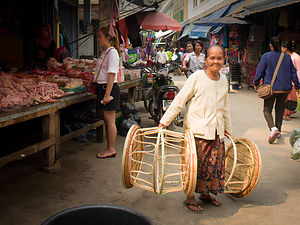 My favorite Myanmar grandmaBack outside the nunnery, our tuk tuk train was faithfully waiting for us to deliver us to our next destination - the street markets, where the people of the village would come each morning to get their food for the day.
My favorite Myanmar grandmaBack outside the nunnery, our tuk tuk train was faithfully waiting for us to deliver us to our next destination - the street markets, where the people of the village would come each morning to get their food for the day.
It was crowded and we once again found ourselves dodging motorbikes weaving their way through the market, carrying entire families and the contents of their households on them.
We bypassed the meats, fruits, and vegetables and stopped at a stall selling betel quids - meant to be chewed like we Westerners chew gum, except that they are a stimulant and can give you a bit of a buzz. They use it the way we use tobacco or caffeine to get a bit of a pick me up, except this is much more potent.
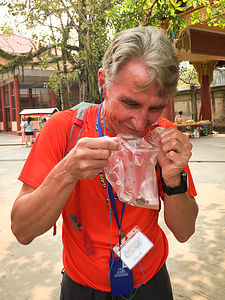 Herb enjoying his betel juiceWe watched as a merchant laid out a betel leaf, coated it with slaked lime, sprinkled some tobacco and areca nuts on top and then rolled the leaf. They are extremely popular in Southeast Asia and the reason you see many people with teeth stained red from the juice.
Herb enjoying his betel juiceWe watched as a merchant laid out a betel leaf, coated it with slaked lime, sprinkled some tobacco and areca nuts on top and then rolled the leaf. They are extremely popular in Southeast Asia and the reason you see many people with teeth stained red from the juice.
Udom said he was buying, but there were only a few takers in our group, Herb and a reluctant me included. As we strolled the market, we began chewing. I thought it was pretty disgusting and after just a minute or two spit it out into a tissue I fortunately had in my pack. There are no public garbage bins in Tachileik - we were on our own. Herb, however, forged on and did admit to getting a bit of a buzz before finally spitting it out.
Back on our tuk tuks we head up a steep hill to the Scwe Dagon Pagoda, a golden stupa used for meditation and rituals as well as a reliquary for the remains of Buddhist monks.
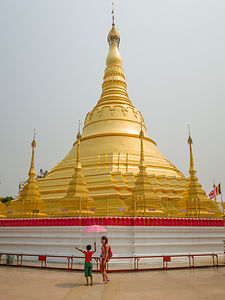 Scwe Dagon Pagoda (Myanmar)Before entering, however, we were exposed to another Burmese tradition, having our faces painted with Thanakha, a yellowish-white cosmetic paste made from ground bark. All the women and girls, and even some men and boys, were wearing it, both for its aesthetics as well as protection from the sun.
Scwe Dagon Pagoda (Myanmar)Before entering, however, we were exposed to another Burmese tradition, having our faces painted with Thanakha, a yellowish-white cosmetic paste made from ground bark. All the women and girls, and even some men and boys, were wearing it, both for its aesthetics as well as protection from the sun.
I sat still while a woman applied a circular patch on each of my cheeks as well as a stripe down my nose. She even suckered me into buying a bottle to bring home.
As we entered the Pagoda grounds, the woman I bought the Thanakha from pointed me out to a little boy, probably about 6 or 7 years old, who was apparently assigned to escort me through the Pagoda. He was adorable and as little as he was, he struggled somewhat successfully to keep me shaded from the sun by holding an umbrella over my head.
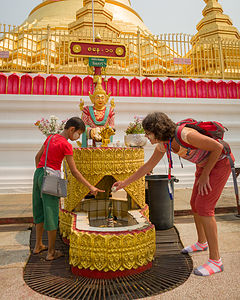 Lolo's little friend helping her through her Buddhist ritualsNot knowing what to do with him, I began, to his dismay, wandering somewhat aimlessly around the pagoda. This was obviously disturbing him, but we had no way of communicating, as he knew no English and my Burmese was even worse.
Lolo's little friend helping her through her Buddhist ritualsNot knowing what to do with him, I began, to his dismay, wandering somewhat aimlessly around the pagoda. This was obviously disturbing him, but we had no way of communicating, as he knew no English and my Burmese was even worse.
Finally, sensing our (or more correctly, my) confusion, his mother intervened and asked me what day of the week I was born on. Not knowing the answer, and appearing even more foolish than the two of them probably already thought I was, she consulted a book and told me “Saturday.” I later found out that I was actually born on a Thursday - oh well..
Apparently, it is very important for Burmese Buddhists to know on which day of the week they are born, because this determines at which of the 8 stations (for some reason Wednesday has two) I should perform my spiritual ritual.
Happy now that we had some structure to our wandering, my little friend brought me to the Saturday shrine, where I followed his lead pouring water, laying flowers, etc. Then, for the grand finale, he brought me over to a gong which I got to ring. I think he was anxious to get rid of me.
 Herb's farm fresh lunchOur last stop in Myanmar was at their equivalent of a shopping mall, a crowded street lined with vendors selling all sorts of counterfeit goods. We managed to resist the temptation of buying anything, but some of our fellow Gate1 companions did not. I think the most ironic purchase by one of the women on our tour was a Hello Kitty suitcase to hold all the other stuff she was buying along the way.
Herb's farm fresh lunchOur last stop in Myanmar was at their equivalent of a shopping mall, a crowded street lined with vendors selling all sorts of counterfeit goods. We managed to resist the temptation of buying anything, but some of our fellow Gate1 companions did not. I think the most ironic purchase by one of the women on our tour was a Hello Kitty suitcase to hold all the other stuff she was buying along the way.
Walking back across the bridge into Thailand, we felt a collective sense of relief to be back in Thailand, whose modernization and progress we now appreciated even more.
It felt like we had already gotten in a full day of touring, but it was only a little past noon when we crossed back into Thailand. We gathered our Gate1 companions who had remained in Mae Sai during our jaunt into Myanmar and headed off to our next event of the day, which was lunch at a farm, with all locally grown and raised food.
The road into the farm was not meant for giant tour buses, so we were loaded onto three farm trucks and brought to our hosts’ home. Lunch was great. Herb had the tilapia, which was served head and all, and I had the chicken wings, which looked much more like the actual wing than anything I have ever had in the states. It was delicious.
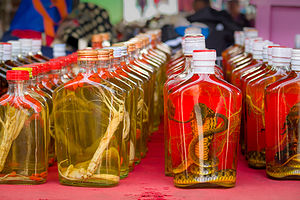 Laos cocktail hour - complete with tiger penisAfter lunch, we drove to the Golden Triangle where the Mekong River forms the border between Thailand, Laos, and Myanmar. From there we boarded a longtail boat which took us on a short tour up and down the river before dropping us off on the small island of Don Sao in Laos. It’s the only part of Laos that can be visited without a visa.
Laos cocktail hour - complete with tiger penisAfter lunch, we drove to the Golden Triangle where the Mekong River forms the border between Thailand, Laos, and Myanmar. From there we boarded a longtail boat which took us on a short tour up and down the river before dropping us off on the small island of Don Sao in Laos. It’s the only part of Laos that can be visited without a visa.
Basically, it’s a tourist trap with a large market filled with local handicrafts, opium paraphernalia, faux designer bags, and the ubiquitous elephant pants -- which I did buy more of as gifts for my sons and their girlfriends. I unsuccessfully tried to haggle down the usual 100 baht (about $3) price since I was buying four, but even my walking away didn’t work. I later learned that they have a no haggling rule on the island, so I was glad to learn that it wasn’t just my poor haggling skills.
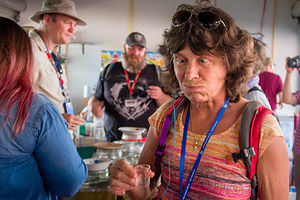 Lolo's first taste of whiskey soaked tiger penis - she likes it!However, our best experience on the island, besides standing next to the sign showing that we we were in Laos, was having a shot of tiger penis whiskey - that’s right, whiskey from a bottle with a tiger penis sitting in it. Herb was intrigued at its possible side effects. There were also some with pickled cobras and scorpions to choose from. I’m not a big hard liquor fan, especially when soaked with strange body parts, but it seemed like the appropriate thing to do.
Lolo's first taste of whiskey soaked tiger penis - she likes it!However, our best experience on the island, besides standing next to the sign showing that we we were in Laos, was having a shot of tiger penis whiskey - that’s right, whiskey from a bottle with a tiger penis sitting in it. Herb was intrigued at its possible side effects. There were also some with pickled cobras and scorpions to choose from. I’m not a big hard liquor fan, especially when soaked with strange body parts, but it seemed like the appropriate thing to do.
This day just wouldn’t quit. After getting back to the Thailand side of the Mekong River on our longtail boat, Udom gave us free time to explore Golden Triangle Park where there was a very interesting Hall of Opium Museum, a big part of this area’s economy for literally thousands of years.
Exhausted and overwhelmed, we returned to our beautiful accommodations at Le Meridien Chiang Rai Resort, where we logged some well-earned relaxation time at its beautiful pool.
Day 3 - Karen Long Neck Tribe of Mae Salong
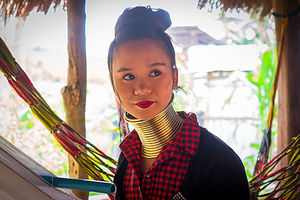 Karen Long Neck womanBefore continuing on to Chiang Mai, we had one more stop to make in the Chiang Rai Province this morning - Mae Salong, a village inhabited by the Karen Long Neck tribe. This too was an optional add-on to our tour, but this time the entire group had signed on.
Karen Long Neck womanBefore continuing on to Chiang Mai, we had one more stop to make in the Chiang Rai Province this morning - Mae Salong, a village inhabited by the Karen Long Neck tribe. This too was an optional add-on to our tour, but this time the entire group had signed on.
So, just who are these exotic people? They were originally from the hills on the Myanmar side of the Thai border, but fled to Thailand in the late 1980s because of civil war and political unrest. While life is much better for the Karen that fled to Thailand, they are still considered refugees and do not have options for gaining Thai citizenship. As a result, they are confined to small villages in the north and kept separate from most of modern Thailand. On a positive note, this has allowed them to keep their culture and traditions alive.
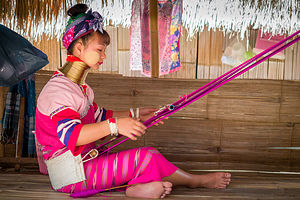 Long Neck woman weavingChoosing to visit this village did not come with a totally clean conscience. While some say tourism gives the Long Neck people an opportunity to make a living while still retaining their culture, others consider it exploitation and a type of human zoo where tourists come to gawk and take photos. I think it is a bit of both. In any case, we were here and the best we could do was show our respect and admiration for their traditions, and even more importantly, buy something that was actually made in the village.
Long Neck woman weavingChoosing to visit this village did not come with a totally clean conscience. While some say tourism gives the Long Neck people an opportunity to make a living while still retaining their culture, others consider it exploitation and a type of human zoo where tourists come to gawk and take photos. I think it is a bit of both. In any case, we were here and the best we could do was show our respect and admiration for their traditions, and even more importantly, buy something that was actually made in the village.
The reason over 40,000 people a year visit these hill tribe villages is to see the exotic women (and little girls) whose necks appear so long that their heads seem to be magically disembodied, hovering above a coil of golden rings. Like magic tricks, this too is an illusion. Contrary to popular belief, the coils don’t lengthen the neck itself, but rather they push the shoulders and rib cages down, just making their necks seem long.
 Lolo trying to haggle this little girl out of a few bahtsThe Karen long neck women begin wearing rings when they are about four or five years old. Every year afterwards until their 21st birthday, a ring is added, eventually reaching as much as 25 pounds. The origin of this tradition is a mystery even to the tribe itself. An ancient legend claims that the rings protected villagers from tiger attacks. Another theory is that the rings were purely aesthetic - worn as an accessory to make women more beautiful.
Lolo trying to haggle this little girl out of a few bahtsThe Karen long neck women begin wearing rings when they are about four or five years old. Every year afterwards until their 21st birthday, a ring is added, eventually reaching as much as 25 pounds. The origin of this tradition is a mystery even to the tribe itself. An ancient legend claims that the rings protected villagers from tiger attacks. Another theory is that the rings were purely aesthetic - worn as an accessory to make women more beautiful.
Whatever the reason, the tradition has made them a real tourist attraction and, as a result, has given them a means to feed and support their families. Exploitation? Perhaps, but their lives seemed peaceful and comfortable compared to what conditions could have been like for them back in Myanmar.
As we walked through their village, I tried hard not to gawk, but to view them as people just like us, trying to do the best they can with the opportunities presented to them. At each stall, there was a colorfully dressed woman or girl with shiny rings around their neck, busily knitting and weaving and selling their handicrafts. It seemed a bit staged, as if it was showtime, and they were performing for us.
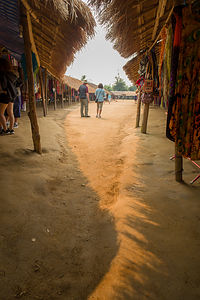 Long Neck VillageUdom had warned us that if we really wanted to help them, we should buy crafts made in the village rather than things produced in China, which you could pretty much find anywhere in Thailand.
Long Neck VillageUdom had warned us that if we really wanted to help them, we should buy crafts made in the village rather than things produced in China, which you could pretty much find anywhere in Thailand.
At one stall, there was an adorable little girl, probably about 8 years old, with about 4 inches of rings around her neck and lovely circles of Thanaka painted on her face, standing in front of a table of handicrafts. As I slowly walked by, I heard her implore me to “Buy someting.” I started admiring the rather crude wood carvings of little longneck people on the table behind her. I tried asking her which one she liked best, which she eventually understood, and thrust one towards me while saying “40 baht” (about $1.25).
I looked around for Herb and his wallet, but he was nowhere to be found. I searched my pockets, but came up with only 20 baht (63 cents). I tried to just give the money to her without taking the figurine, but that was not the way it worked. She wanted to sell me something, not take charity. Finally, she said, “20 baht” and we made the exchange. Oh, great. My first successful haggle was cheating this little girl out of 63 cents.
Between the little boy that led me through my spiritual rituals at the Scwe Dagon Pagoda in Tachileik yesterday and this little girl today, I had fallen in love with the beautiful, soft spoken children of Myanmar - so unspoiled and mature in their ability and willingness to participate in the life of their village.
- ‹ previous
- 4 of 7
- next ›
Chiang Rai location map in "high definition"
Javascript is required to view this map.
